If you want to be a successful pitcher, then you will need to develop a quality change-up. As discussed before on The Full Windup, the change-up is the most underrated pitch in baseball. The reason a change-up is so effective is because of its deception. The change-up can really disrupt a hitter’s timing, and even the most mechanically sound hitter can have a tough time recognizing a good change-up as it leaves the pitcher’s hand.
There are numerous ways to grip a change-up: straight change, palm ball, vulcan change, circle change-up, and the list goes on. For our purposes, we will tackle the two most common and basic change-up grips.
The Straight Change
The most basic of change-up grips is the straight change. This change-up is usually taught to younger pitchers who have smaller hands or are just learning the pitch for the first time. The grip is very simple. Take your normal 4-seam fastball grip, add your ring finger to the baseball, and then bury the ball back toward your palm. The thumb will be positioned under the baseball while the pinky finger rests off the ball or on the side of the baseball. There should be no space between the baseball and the hand. This allows for more friction upon release of the pitch which in turn helps slow the pitch down.
The straight change, or 3-finger change-up, is more or less a straight pitch. The pitcher’s windup, delivery, and arm action should look identical to when a fastball is being thrown. In effect, the pitcher should let the grip do all the work.
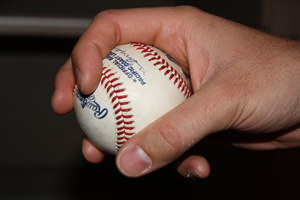 After a younger pitcher learns to master his 4-seam and 2-seam fastball, this is the next best pitch to teach him. Stay away from the breaking pitches until he is physically mature enough and can throw his fastball and change-up for strikes. When first teaching this pitch, emphasize keeping it down in the zone. Ideally, we would like to be able to locate this pitch on the outside corner, but younger pitchers need to learn the importance of throwing off-speed pitches down in the strike zone first.
After a younger pitcher learns to master his 4-seam and 2-seam fastball, this is the next best pitch to teach him. Stay away from the breaking pitches until he is physically mature enough and can throw his fastball and change-up for strikes. When first teaching this pitch, emphasize keeping it down in the zone. Ideally, we would like to be able to locate this pitch on the outside corner, but younger pitchers need to learn the importance of throwing off-speed pitches down in the strike zone first.
A few years back, I was helping coach a 9-10 year old travel team and many of the kids were just learning how to pitch. We spent the first half of the year working on locating their fastball to the inside and outside corners. When it came time to teach them a change-up, this is the grip I taught them. Some of them struggled with the pitch at first, and they would leave the pitch high in the strike zone around the hitter’s uniform letters. As you would expect, these pitches were hit hard. To really drive the point home of pitching down in the zone, I told them to try to bounce their change-up on the plate. Wow, what a difference! We had opposing hitters swinging at pitches that were barely making it to the plate all because our 9-year-old pitcher was able to keep his delivery and arm speed identical to his fastball, and keep the ball down in the zone.
The Circle Change-up
The circle change-up is a great pitch for the pitcher who has already mastered the straight change-up and is looking to add some movement to his change. By utilizing the circle change-up grip, the pitcher can do a few more things at release point to make the ball tail away from a left-handed hitter, or even cut away from a right-handed hitter (as a RHP).
The circle change-up is gripped by forming a circle with the index finger and thumb, and then burying the ball in the back part of the hand or palm. The middle finger and ring finger cross the seams similar to a 4-seam fastball, and the pinky finger rests on the side of the baseball. Unlike a fastball grip, there should not be a lot of space between the ball and the hand.
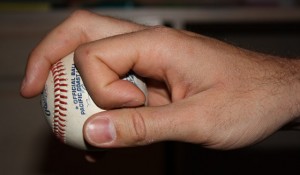 Just as with the straight change, the pitcher needs to keep his windup, delivery, and arm speed identical to his fastball, and let his grip take care of the speed of the pitch. As for adding a little movement to the pitch, most pitchers will find that there is a natural tendency for the ball to move toward the pitcher’s arm side. So for a right-handed pitcher, the ball will tail away from a lefty. For a left-handed pitcher, the baseball would naturally tail away from a righty. To get a little more movement on the pitch, the pitcher can pronate his wrist (turn the circle side of his grip downward) at release point. This will give the ball more tailing-action as is dives down in the zone.
Just as with the straight change, the pitcher needs to keep his windup, delivery, and arm speed identical to his fastball, and let his grip take care of the speed of the pitch. As for adding a little movement to the pitch, most pitchers will find that there is a natural tendency for the ball to move toward the pitcher’s arm side. So for a right-handed pitcher, the ball will tail away from a lefty. For a left-handed pitcher, the baseball would naturally tail away from a righty. To get a little more movement on the pitch, the pitcher can pronate his wrist (turn the circle side of his grip downward) at release point. This will give the ball more tailing-action as is dives down in the zone.
Many believe that the change-up is not an out pitch. However, a quality change-up can keep hitters off balance and cause them to swing through the pitch, or cause them to put a weakly hit ball in play. Furthermore, it can make your fastball appear even faster. Most RHP’s have a breaking pitch that will break away from right-handed hitters, and LHP’s a pitch that will break away from lefties. A quality circle change-up can give a RHP a pitch in his arsenal that will break down and away from a left-handed hitter (similar to a screwball without the same stress on the arm). And the same holds true for a LHP against a right-handed hitter. It’s a deceptive pitch that is hard for a hitter to pick up. And though it’s not as exciting as a 95 MPH fastball or a nasty slider, it’s effectiveness is proof of how great of a pitch it really is.
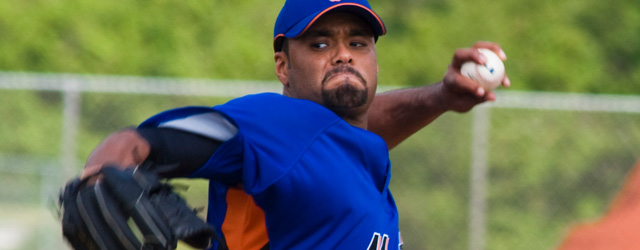
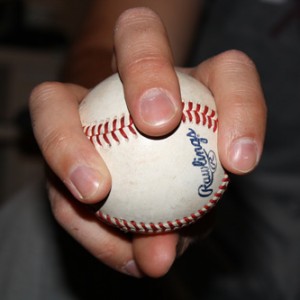
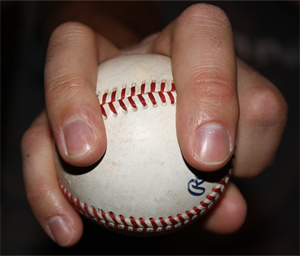

Leave a Reply